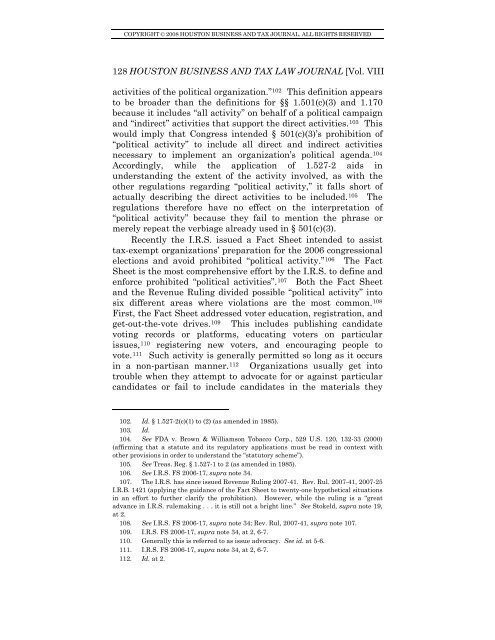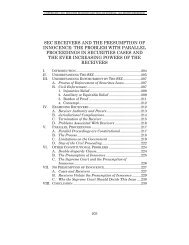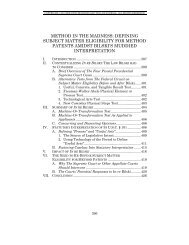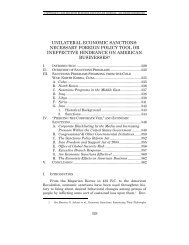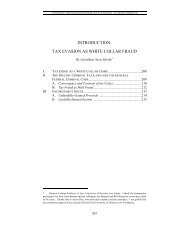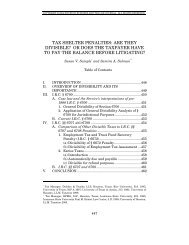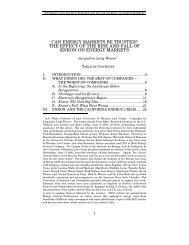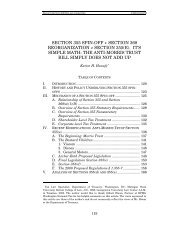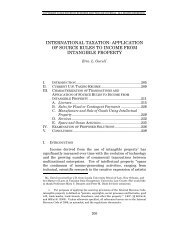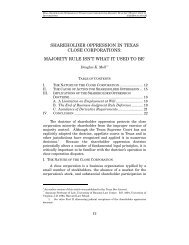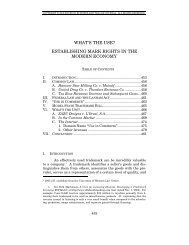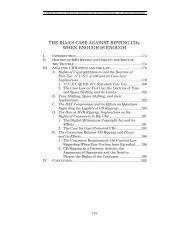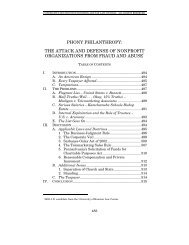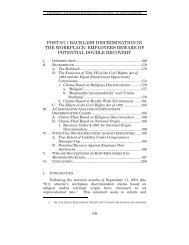Eyes Wide Shut: The Ambiguous ?Political Activity? - Houston ...
Eyes Wide Shut: The Ambiguous ?Political Activity? - Houston ...
Eyes Wide Shut: The Ambiguous ?Political Activity? - Houston ...
You also want an ePaper? Increase the reach of your titles
YUMPU automatically turns print PDFs into web optimized ePapers that Google loves.
COPYRIGHT © 2008 HOUSTON BUSINESS AND TAX JOURNAL. ALL RIGHTS RESERVED<br />
128 HOUSTON BUSINESS AND TAX LAW JOURNAL [Vol. VIII<br />
activities of the political organization.” 102 This definition appears<br />
to be broader than the definitions for §§ 1.501(c)(3) and 1.170<br />
because it includes “all activity” on behalf of a political campaign<br />
and “indirect” activities that support the direct activities. 103 This<br />
would imply that Congress intended § 501(c)(3)’s prohibition of<br />
“political activity” to include all direct and indirect activities<br />
necessary to implement an organization’s political agenda. 104<br />
Accordingly, while the application of 1.527-2 aids in<br />
understanding the extent of the activity involved, as with the<br />
other regulations regarding “political activity,” it falls short of<br />
actually describing the direct activities to be included. 105 <strong>The</strong><br />
regulations therefore have no effect on the interpretation of<br />
“political activity” because they fail to mention the phrase or<br />
merely repeat the verbiage already used in § 501(c)(3).<br />
Recently the I.R.S. issued a Fact Sheet intended to assist<br />
tax-exempt organizations’ preparation for the 2006 congressional<br />
elections and avoid prohibited “political activity.” 106 <strong>The</strong> Fact<br />
Sheet is the most comprehensive effort by the I.R.S. to define and<br />
enforce prohibited “political activities”. 107 Both the Fact Sheet<br />
and the Revenue Ruling divided possible “political activity” into<br />
six different areas where violations are the most common. 108<br />
First, the Fact Sheet addressed voter education, registration, and<br />
get-out-the-vote drives. 109 This includes publishing candidate<br />
voting records or platforms, educating voters on particular<br />
issues, 110 registering new voters, and encouraging people to<br />
vote. 111 Such activity is generally permitted so long as it occurs<br />
in a non-partisan manner. 112 Organizations usually get into<br />
trouble when they attempt to advocate for or against particular<br />
candidates or fail to include candidates in the materials they<br />
102. Id. § 1.527-2(c)(1) to (2) (as amended in 1985).<br />
103. Id.<br />
104. See FDA v. Brown & Williamson Tobacco Corp., 529 U.S. 120, 132-33 (2000)<br />
(affirming that a statute and its regulatory applications must be read in context with<br />
other provisions in order to understand the “statutory scheme”).<br />
105. See Treas. Reg. § 1.527-1 to 2 (as amended in 1985).<br />
106. See I.R.S. FS 2006-17, supra note 34.<br />
107. <strong>The</strong> I.R.S. has since issued Revenue Ruling 2007-41. Rev. Rul. 2007-41, 2007-25<br />
I.R.B. 1421 (applying the guidance of the Fact Sheet to twenty-one hypothetical situations<br />
in an effort to further clarify the prohibition). However, while the ruling is a “great<br />
advance in I.R.S. rulemaking . . . it is still not a bright line.” See Stokeld, supra note 19,<br />
at 2.<br />
108. See I.R.S. FS 2006-17, supra note 34; Rev. Rul, 2007-41, supra note 107.<br />
109. I.R.S. FS 2006-17, supra note 34, at 2, 6-7.<br />
110. Generally this is referred to as issue advocacy. See id. at 5-6.<br />
111. I.R.S. FS 2006-17, supra note 34, at 2, 6-7.<br />
112. Id. at 2.


